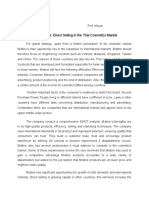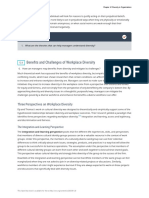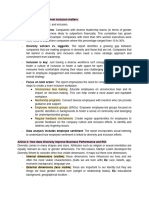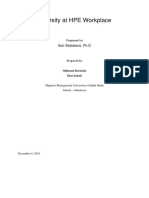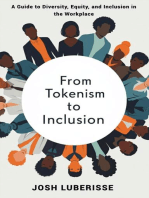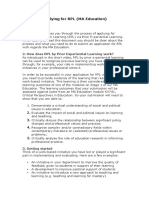Thomas & Ely (1996) - "Making Differences Matter: A New Paradigm For Managing Diversity," Harvard Business Review
Thomas & Ely (1996) - "Making Differences Matter: A New Paradigm For Managing Diversity," Harvard Business Review
Uploaded by
Edison Bitencourt de AlmeidaCopyright:
Available Formats
Thomas & Ely (1996) - "Making Differences Matter: A New Paradigm For Managing Diversity," Harvard Business Review
Thomas & Ely (1996) - "Making Differences Matter: A New Paradigm For Managing Diversity," Harvard Business Review
Uploaded by
Edison Bitencourt de AlmeidaOriginal Title
Copyright
Available Formats
Share this document
Did you find this document useful?
Is this content inappropriate?
Copyright:
Available Formats
Thomas & Ely (1996) - "Making Differences Matter: A New Paradigm For Managing Diversity," Harvard Business Review
Thomas & Ely (1996) - "Making Differences Matter: A New Paradigm For Managing Diversity," Harvard Business Review
Uploaded by
Edison Bitencourt de AlmeidaCopyright:
Available Formats
Making Differences Matter: A New Paradigm for Managing Diversity
This summary of the article includes excerpts, concepts, and references from the
following article:
Thomas & Ely (1996). “Making Differences Matter: A New Paradigm for Managing
Diversity,” Harvard Business Review
Purpose of this reading:
In the global economy of the 21st century, diverse teams are a cornerstone of
successful organizations. As future global leaders, it is important to understand where
firms fail despite their best efforts at encouraging diversity within the workplace. The
following summary of Thomas and Ely’s Making Differences Matter, A New Paradigm
for Managing Diversity will demonstrate the key difference between truly embracing
cultural differences as opposed to just applying diversity in the hiring practices.
Throughout this material, generate your examples of the different paradigms given.
Have you ever had experiences in a company that forced assimilation onto its
employees? Did you, or anyone you know feel trapped into their role solely based on
their diversity? Begin matching your personal experiences and observations to the
concepts within the summary while also brainstorming how implementing the integration
paradigm could mitigate some of those problems.
Summary:
A diverse workforce has been linked to increased profitability. Additionally, according to
research by Thomas and Ely, the benefits of diversity can include “[improved] learning,
creativity, flexibility, organizational and individual growth, and the ability of a company to
adjust rapidly and successfully to market changes.” Truly embracing diversity enables
organizations to capture the full value created by their employees.
Their research shows that most efforts to increase diversity are driven by increasing the
number of individuals from “traditionally underrepresented ‘identity groups.’” In the US,
this translates to hiring females and individuals from specific ethnic groups. Most efforts
stop here. Traditionally, companies expand workplace diversity in one of two ways: the
Discrimination-and-Fairness Paradigm or the Learning-and-Effectiveness Paradigm.
The Discrimination-and-Fairness Paradigm is the most common approach. This
paradigm is often accompanied by a call for increased respect for cultural differences,
as well as the creation of development programs for the targeted groups. The success
or failure of these programs is generally determined by recruitment and retention rates.
A major drawback to this paradigm is that, typically, the expectation communicated is
that all employees are equal. In practice, this perspective can wash away the
advantages of having a diverse workforce.
The second paradigm is the Access-and-Legitimacy Paradigm. The objective is to hire
for diversity and then use the identity groups to interact with matching clients or other
key stakeholders. For example, a firm may hire a Latino employee to interact with
Hispanic clients. While this paradigm provides the opportunity for employees to apply
their cultural backgrounds in the workplace, it tends to pigeon-hold selected employees
into specific roles, often with little or no room for growth.
Thomas and Ely devised a third paradigm that blends these two approaches: The
Integration Paradigm. This approach comprises the important first step of encouraging
the hiring and retaining of diverse employees, while also allowing them to use their
diverse experiences to shape all facets of the business. The major difference is that
integration seeks to draw out the essential value-added of diversity: cognitive originality.
The ways in which individuals solve problems or complete tasks is often based on their
cultural backgrounds. Insights and innovations are dampened when people from
different cultures or identity groups are assimilated fully into the dominant culture. Also,
when diverse employees isolated into interacting only with clients or other stakeholders
of their same identity group, opportunities for learning and innovating are diminished. By
bringing diverse cultures into one place and integrating them into the organization, all
employees can benefit as they learn from one another. Moreover, complex problems
may be solved more readily when diverse individuals are given voice via the integration
paradigm.
Per Thomas and Ely, there are eight criteria for successful implementation of the
Integration Paradigm:
1.) The company places a premium on opinions and insights coming from any location,
2.) Management accepts both learning outcomes and potential pitfalls attributable to
encouraging differing opinions from multiple sources and cultures,
3.) The organizational requires high performance from all employees,
4.) Professional development is a cornerstone of the organization,
5.) Organizational structures are in place to mediate conflicts that may arise out of
differences of opinions,
6.) The company values their employees,
7.) The mission of the company is strong and understood by employees,
8.) The company structure is egalitarian in nature, so that hierarchical and dominant
subcultures cannot suppress the fruits of integration.
You might also like
- Music Therapy Treatment PlanDocument3 pagesMusic Therapy Treatment Planapi-294168248100% (5)
- Course Syllabus: TAM 542 - Global Leadership and Personal Leadership DevelopmentDocument6 pagesCourse Syllabus: TAM 542 - Global Leadership and Personal Leadership DevelopmentEdison Bitencourt de AlmeidaNo ratings yet
- Analisis of The Satera CaseDocument3 pagesAnalisis of The Satera CaseMariano BonillaNo ratings yet
- Navigating The Cultural MindfieldDocument3 pagesNavigating The Cultural MindfieldEdison Bitencourt de Almeida100% (1)
- Creating The Best Workplace On EarthDocument2 pagesCreating The Best Workplace On EarthEdison Bitencourt de AlmeidaNo ratings yet
- Assessment Task 2: Section Two: RationaleDocument7 pagesAssessment Task 2: Section Two: Rationaleapi-359367465No ratings yet
- Running Head: Chris and Alison Weston 1Document5 pagesRunning Head: Chris and Alison Weston 1Anindya BasuNo ratings yet
- Case Questions - Wil - Sand - WildDocument1 pageCase Questions - Wil - Sand - WildcristianoNo ratings yet
- Case Study OMDocument2 pagesCase Study OMRajansha R ReniNo ratings yet
- Henry Tam and MGI TeamDocument35 pagesHenry Tam and MGI TeamAditya Dhekane50% (4)
- Westlake Lanes Case Study QuestionsDocument1 pageWestlake Lanes Case Study QuestionsABM20140% (2)
- 1 Pemberton's Dilemma Reflective PaperDocument5 pages1 Pemberton's Dilemma Reflective PaperCarlos CarranzaNo ratings yet
- DocxDocument2 pagesDocxBryan Norwayne60% (5)
- Managing Workplace Diversity: Building Effective and Efficient Work RelationshipsFrom EverandManaging Workplace Diversity: Building Effective and Efficient Work RelationshipsNo ratings yet
- Global Leadership and Personal Leadership DevelopmentDocument3 pagesGlobal Leadership and Personal Leadership DevelopmentEdison Bitencourt de AlmeidaNo ratings yet
- Jeopardy ReviewDocument2 pagesJeopardy Reviewshelbie611No ratings yet
- James F. Alexander, Holly Barrett Waldron, Michael S. Robbins, and Andrea A. Neeb-Functional Family Therapy For Adolescent Behavior Problems-American Psychological Association (APDocument269 pagesJames F. Alexander, Holly Barrett Waldron, Michael S. Robbins, and Andrea A. Neeb-Functional Family Therapy For Adolescent Behavior Problems-American Psychological Association (APAnonymous Hfcj6C100% (3)
- Basic Counseling SkillsDocument58 pagesBasic Counseling Skillsshimeath delrosarioNo ratings yet
- Leadership Styles-Mckinsey EdDocument14 pagesLeadership Styles-Mckinsey EdcrimsengreenNo ratings yet
- Threadless CaseDocument3 pagesThreadless CaseBasile ParovelNo ratings yet
- How You Manage An Offsite TeamDocument4 pagesHow You Manage An Offsite TeamErol CarkadzicNo ratings yet
- Assessment Task - JUNE 2022: Course Work II: Individual Written AssignmentDocument4 pagesAssessment Task - JUNE 2022: Course Work II: Individual Written AssignmentJayanta ChakrabortyNo ratings yet
- Cola Wars CaseDocument11 pagesCola Wars CaseAneeshKKedlayaNo ratings yet
- Team A Case 1 - Satera CaseDocument4 pagesTeam A Case 1 - Satera CaseJúlia Moura CardosoNo ratings yet
- Report 2Document4 pagesReport 2Trang PhamNo ratings yet
- Wac ReportDocument10 pagesWac ReportSiddharthNo ratings yet
- An Industry Analysis Through Porter's Five Forces Reveals That Market ...Document8 pagesAn Industry Analysis Through Porter's Five Forces Reveals That Market ...oterobodasNo ratings yet
- Cola Wars ContinueDocument4 pagesCola Wars ContinueAssignmentLab.comNo ratings yet
- Guide - Mistine Direct Selling in The Thai Cosmetics MarketDocument25 pagesGuide - Mistine Direct Selling in The Thai Cosmetics MarketThox Sic100% (1)
- United Breaks Guitar Case SummaryDocument1 pageUnited Breaks Guitar Case SummaryMazhar IqbalNo ratings yet
- Resource Based View (RBV) of Competitive Advantage - An OverviewDocument21 pagesResource Based View (RBV) of Competitive Advantage - An Overviewsohaiblatif31100% (1)
- The Elusive Green ConsumerDocument15 pagesThe Elusive Green ConsumerJason StoneNo ratings yet
- Case2: Liulishuo: AI English TeacherDocument3 pagesCase2: Liulishuo: AI English TeacherSoubhagya DashNo ratings yet
- Case Analysis of Huella Online TravelDocument6 pagesCase Analysis of Huella Online TravelPriyatham Kireeti67% (3)
- Mistine: Direct Selling in The Thai Cosmetics MarketDocument2 pagesMistine: Direct Selling in The Thai Cosmetics MarketAmy Rose Abalunan100% (1)
- Warren BuffeDocument4 pagesWarren BuffeastrdppNo ratings yet
- Bitter CompetitionDocument18 pagesBitter CompetitionAnimeshNo ratings yet
- Coke Vs PepsiDocument3 pagesCoke Vs PepsiKanishk MendevellNo ratings yet
- This Study Resource Was: Coffee ContractDocument2 pagesThis Study Resource Was: Coffee ContractElad Breitner100% (1)
- Discussion Questions (Participation)Document4 pagesDiscussion Questions (Participation)Sam SamNo ratings yet
- RBC CaseAnswers Group13Document4 pagesRBC CaseAnswers Group13Jayesh KukretiNo ratings yet
- MD 1 Legal AspectDocument7 pagesMD 1 Legal AspectCecilia Rago RafolNo ratings yet
- Article Review by Marchel Rumlaklak - Making Differences Matter: A New Paradigm For Managing DiversityDocument7 pagesArticle Review by Marchel Rumlaklak - Making Differences Matter: A New Paradigm For Managing DiversityMarchel Pierson Rumlaklak100% (4)
- The Discrimination and Fairness ParadigmDocument5 pagesThe Discrimination and Fairness ParadigmArshia KhareNo ratings yet
- Waleed Zainab FurqanDocument6 pagesWaleed Zainab FurqanFurqan AhmedNo ratings yet
- Validation of The Inclusion Skills Measurement Profile - Summary of Phase 1Document7 pagesValidation of The Inclusion Skills Measurement Profile - Summary of Phase 1carlosadmgoNo ratings yet
- GCE Assignment: Diversity Management: Group Research and Report WritingDocument4 pagesGCE Assignment: Diversity Management: Group Research and Report WritingJeremiah UrimNo ratings yet
- Principles of Management-OpenStax-part 2Document271 pagesPrinciples of Management-OpenStax-part 2lt castroNo ratings yet
- Group C - DEI Notes and Discussion Questions - 2Document5 pagesGroup C - DEI Notes and Discussion Questions - 2alicja.szczypinska01No ratings yet
- Equality and Diversity Assignment TwoDocument7 pagesEquality and Diversity Assignment TwoLusa Mulonga JkrNo ratings yet
- HS1314 Slides For Endsem 2023 SpringDocument54 pagesHS1314 Slides For Endsem 2023 SpringSahasrabda Sai PradhanNo ratings yet
- Project OBDocument21 pagesProject OBMohammad Shafay ShahidNo ratings yet
- Equal Opportunities & Managing Diversity.: Only 4.99Document10 pagesEqual Opportunities & Managing Diversity.: Only 4.99Afsheen Danish NaqviNo ratings yet
- Workforce Diversity - HRMDocument5 pagesWorkforce Diversity - HRMMercutio Goins100% (1)
- Diversity and Inclusion FinalDocument7 pagesDiversity and Inclusion FinalNate ScarrittNo ratings yet
- LOB Final Paper DraftDocument15 pagesLOB Final Paper DraftahmadkarmilaNo ratings yet
- Workforce Diversity Management: Biggest Challenge or Opportunity For 21st Century OrganizationsDocument6 pagesWorkforce Diversity Management: Biggest Challenge or Opportunity For 21st Century Organizationsderrel251706No ratings yet
- Work Force Diversity: SynopsisDocument17 pagesWork Force Diversity: SynopsisAfsheen Danish NaqviNo ratings yet
- Onlineblogposts2and3 RavneetsinghsidhuDocument6 pagesOnlineblogposts2and3 RavneetsinghsidhuInderbir KaurNo ratings yet
- Diversity in BusinessDocument19 pagesDiversity in Businesssong neeNo ratings yet
- Benefits and Challenges of Adopting A Diversity Management ApproachDocument13 pagesBenefits and Challenges of Adopting A Diversity Management ApproachjanesteveNo ratings yet
- HRM Workplace DiversityDocument36 pagesHRM Workplace DiversityNeha Gulati100% (3)
- Perez Written ReportDocument8 pagesPerez Written ReportHarly CarinalNo ratings yet
- Building An Inclusive Diversity CultureDocument20 pagesBuilding An Inclusive Diversity CulturegpnasdemsulselNo ratings yet
- Diversity ManagementDocument5 pagesDiversity ManagementlilandakwimbeNo ratings yet
- Diversity Management The Challenges & OpportunitiesDocument57 pagesDiversity Management The Challenges & OpportunitiesAmal AbrahamNo ratings yet
- Diversity CorrectionDocument7 pagesDiversity Correctionjosephmainam9No ratings yet
- The Inclusive Leader: Embracing Diversity for Organizational ExcellenceFrom EverandThe Inclusive Leader: Embracing Diversity for Organizational ExcellenceNo ratings yet
- From Tokenism to Inclusion: A Guide to Diversity, Equity, and Inclusion in the WorkplaceFrom EverandFrom Tokenism to Inclusion: A Guide to Diversity, Equity, and Inclusion in the WorkplaceNo ratings yet
- Thriving Together: Cultivating Diversity, Equity, and InclusionFrom EverandThriving Together: Cultivating Diversity, Equity, and InclusionNo ratings yet
- TGM540 Week1 ChecklistDocument1 pageTGM540 Week1 ChecklistEdison Bitencourt de AlmeidaNo ratings yet
- Customer Engagement Is Employee Engagement and Vice Versa OpensourceDocument6 pagesCustomer Engagement Is Employee Engagement and Vice Versa OpensourceEdison Bitencourt de AlmeidaNo ratings yet
- Emotional IntelligenceDocument1 pageEmotional IntelligenceEdison Bitencourt de AlmeidaNo ratings yet
- Literature MatrixDocument3 pagesLiterature MatrixJuvy IringanNo ratings yet
- Assignment 2cognitivetheoriesedid650120162Document7 pagesAssignment 2cognitivetheoriesedid650120162api-349780383No ratings yet
- Lesson Plan 1Document5 pagesLesson Plan 1api-491785165No ratings yet
- Week 1 DQ 1Document1 pageWeek 1 DQ 1Lindsay WatsonNo ratings yet
- Collaboration Project PaperDocument6 pagesCollaboration Project Paperapi-383265219No ratings yet
- Group Counselling Process: Ashraf Farhan Bin Mohd Amin Mohamad Aliff Bin MT Nawi Sidi Omar Alfoadi Bin JamaludinDocument12 pagesGroup Counselling Process: Ashraf Farhan Bin Mohd Amin Mohamad Aliff Bin MT Nawi Sidi Omar Alfoadi Bin JamaludinAliff Aniki100% (1)
- Leadership Tests B5PTDocument3 pagesLeadership Tests B5PTDante Lau Jing TeckNo ratings yet
- Statistics AnxietyDocument17 pagesStatistics Anxietyadri90No ratings yet
- Action Plan in Epp-HertDocument3 pagesAction Plan in Epp-HertTitser Rock SonNo ratings yet
- APA - DSM5 - Severity Measure For Agoraphobia Adult PDFDocument3 pagesAPA - DSM5 - Severity Measure For Agoraphobia Adult PDFMelissandreNo ratings yet
- Dyslexia FinalDocument36 pagesDyslexia FinalRafia Awan100% (1)
- Linao Elementary School: To Reduce The Number of Frustrated and Nonreaders in English by 60%Document6 pagesLinao Elementary School: To Reduce The Number of Frustrated and Nonreaders in English by 60%Aiza BananNo ratings yet
- Patrick Sackey AdofoDocument109 pagesPatrick Sackey AdofoMihaela CîrlanNo ratings yet
- STEP 1 - Personal Reflection: Self-Assessment Is About Taking A Hard Look at Your Skills, Interests, Values andDocument14 pagesSTEP 1 - Personal Reflection: Self-Assessment Is About Taking A Hard Look at Your Skills, Interests, Values andJack Monter100% (1)
- Republic of The Philippines Department of Education Region Iv-A (Calabarzon) Division of Quezon Gumaca, QuezonDocument3 pagesRepublic of The Philippines Department of Education Region Iv-A (Calabarzon) Division of Quezon Gumaca, QuezonAngelina De AsisNo ratings yet
- FranDocument2 pagesFranapi-604348720No ratings yet
- The Stress of Caring: Case Study ReportDocument6 pagesThe Stress of Caring: Case Study ReportChirag BansalNo ratings yet
- Class 11 & 12 - The MSD Effect Dhoni's Leadership Skills - Pdf-Cdekey - J3CCASVTU4XTJIOTTEKNTLAT52XKAR7I PDFDocument3 pagesClass 11 & 12 - The MSD Effect Dhoni's Leadership Skills - Pdf-Cdekey - J3CCASVTU4XTJIOTTEKNTLAT52XKAR7I PDFA SharmaNo ratings yet
- Topic01 Intro HistoryDocument46 pagesTopic01 Intro HistoryFareeha KhanNo ratings yet
- Acmas 2137 - Cost Accounting and Control Topic Outline: Day Topic Activity ExercisesDocument1 pageAcmas 2137 - Cost Accounting and Control Topic Outline: Day Topic Activity Exercisesecho fateNo ratings yet
- LDM Module 5Document4 pagesLDM Module 5ALEXANDRA HALASAN75% (4)
- Math Lesson Plan - Finding PerimeterDocument12 pagesMath Lesson Plan - Finding Perimeterapi-302768850No ratings yet
- Applying For RPL - GuidanceDocument3 pagesApplying For RPL - GuidancekeithturveyNo ratings yet
- Full Rubrics For The Danielson Framework For TeachingDocument23 pagesFull Rubrics For The Danielson Framework For TeachingSanty ManuelNo ratings yet


































